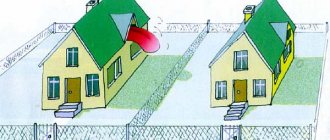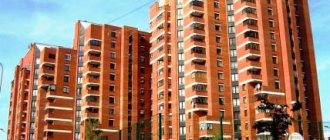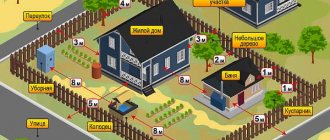The distance from the house to the parking lot is the SNiP norm, which can be found in the updated edition of the set of norms and rules developed back in the era of state standardization. The attitude towards the Soviet-era norms developed in 1989 has not changed; in many ways they remain a valuable collection of practical experience and scientific research. But today it is the set of rules SP 42.13330.2011 that clearly indicates the minimum distance between a parking lot and a residential building. It is a collection of standards for the distances at which a parking lot or place of permanent residence of a car can be located from residential buildings.
Parking in the yard
How is the distance to a residential building determined?
In modern urban conditions, several criteria have emerged that serve as the main components in determining the acceptable distance from the house to the parking lot. The abundance of cars in big cities and even in small towns has led to the emergence of parking lots of different types and varying degrees of equipment.
Previous regulations concerned only places where cars were permanently or temporarily located, called a parking lot, if the vehicle was left for a long time, or a parking lot, where it could be left for a short time.
Yard parking
- Today, the concept of “parking” includes two types (underground and above-ground). But each of them can include a single-level or equipped with several levels. Multi-level above-ground ones can solve the problem of lack of parking space in apartment buildings, where car drivers are sometimes several family members. This presupposes that the inhabitants of one apartment have not one car, but two or more.
- Underground parking requires special conditions, additional equipment and compliance with fire safety rules (air purification hoods, hazard warning and fire extinguishing systems). The use of smart car parks, rooftops of multi-storey buildings or pallet areas have made the regulations for car parks even more relevant. The lack of space to park the car forces the invention of additional devices (such as lawn bars used to protect green spaces).
Placement of parking lots
Fine for parking on a lawn in St. Petersburg
The Legislative Code regarding vehicle parking in St. Petersburg was approved on May 31, 2010, No. 273-70.
It regulates the responsibility for driving a vehicle onto the lawn in Art. 32 of the Code. The following penalties will be imposed on persons who commit such an offense:
- For ordinary drivers – from 3,000 to 5,000 rubles.
- Officials – from 5,000 to 4,0000 rubles
- Institutions – from 150,000 to 500,000 rubles.
Note. If green plants were damaged by a vehicle involved in maintenance work, when planting plants or performing repair work, no fine will be issued.
Distance from parking to residential building
SNiP 2.07.01-89, used in the construction of a residential apartment building, provides not only playgrounds for children and places for potential recreation for adults, but also parking spaces. In this case, the distance from the parking lot to the residential building is calculated in strict accordance with the expected number of cars located. The greater their potential presence, the higher the unfavorable accumulation of exhaust gases, creating a high level of air pollution that is dangerous for residents.
In the city
The distance required by regulatory requirements requires distance from a residential building, the value of which is calculated based on the number of parking spaces.
At a minimum distance of 10 m, with an end location, parking for no more than 10 cars can be provided.
Amount of fines for illegal parking in Moscow and St. Petersburg
Additional standards for distances from houses
The remaining standards for distance from the wall are as follows:
- if the number of parked cars is 50, the required distance in meters is 15 m (10 m when located at the end where there are no windows);
- if the number of parked cars is 100, the required distance in meters is 25 m;
- if the number of parked cars is 300, the required distance in meters is 35 m;
- if the number of parked cars is over 300, the required distance in meters is 50 m (if located at the end, the distance from the wall does not change).
What is the fine for parking on the lawn in 2021?
Fines are imposed in accordance with Art.
12.19 Code of Administrative Offenses of the Russian Federation and regional standards. The penalty for driving a vehicle onto the lawn in 2021 is in the form of a fine and ranges from 500 to 5,000 rubles (the penalty varies in different regions of the Russian Federation). So, for example, in Moscow the sanctions for stopping a vehicle on the lawn are more severe. For example, for individuals - the fine ranges from 4,500 to 5,000 rubles, an official will have to fork out 50,000 rubles, and if the vehicle is registered with an institution, then the amount of the penalty can reach up to 300,000 rubles (Article 8.25 of the Moscow Administrative Code).
According to the legal norms of the Northern capital, the smallest penalty will be 3,000 rubles for ordinary drivers, 5,000 rubles for officials and 150,000 for legal entities. persons
In the regions, such punishment is issued in smaller amounts from 500 to 60,000 rubles.
For example, the Ryazan region adopted standards on December 4, 2008, in which an individual will be fined from 500 to 2000 rubles for stopping on the lawn. If the violation is repeated, the punishment becomes more severe (clause 3.5).
Regional standards of N. Novgorod from 2003 in Art. 3.10 establishes a minimum penalty of 2,000 rubles for ordinary drivers and 60,000 rubles for institutions.
The penalty for stopping a vehicle on a lawn depends on how often the offender commits such offenses. If the vehicle is stopped on the lawn for the first time, the fine will be minimal. If the violation is repeated, the driver will have to fork out a large amount.
Below, for greater clarity, is a table of penalties in the listed regions of the Russian Federation.
Camera fine for parking on the lawn
Most often, a violation of the rules is recorded by a traffic police inspector by drawing up a violation report on the driver on a standard registered form, with a displayed number and a link to the legal norms that were violated.
Additionally, the form displays information about the vehicle, the amount of the fine and the date of the event. At the same time, video cameras are installed in some crowded areas to record violations of parking rules. Facts of camera violations are processed by traffic police officers and within 3 days a notification is sent to the violator with a decision on penalties for violating the Rules. A photograph confirming the fact of the violation is attached to the letter, clearly displaying the license plates of the vehicle and the fact that it was on the lawn.
Note. If a person disagrees with the penalty, it is possible to challenge the decision by filing a complaint with the department that issued the penalty.
Guidelines
In 2004, methodological recommendations were developed that can be followed in megalopolises and big cities. They were written by the Federal Service for the Protection of Consumer Rights and Human Rights Protection and the RMA of the Ministry of Health of the Russian Federation, and signed by the chief sanitary doctor of the Russian Federation.
Car parking in a residential area
The purpose of developing methodological recommendations is to prevent the harmful effects of parking lots and parking lots on residents of residential buildings and people in other types of buildings. According to the developed document, the placement of parking lots and permanent storage areas (including garages) should be carried out in accordance with the table given in SanPiN 2.2.1/2.1.1.1200-03.
Rules for installing a car at an angle in a parking lot
Changes were subsequently made to the adopted recommendations, which were not of fundamental importance and left unchanged the requirements developed in 2004. The following rules were used in the development:
- provided for by sanitary standards for educational institutions, hospitals, maternity hospitals and hospitals;
- fire safety standards were reviewed;
- requirements for the arrangement of entry and exit from parking lots of various types;
- the indispensable presence of ventilation, fire alarms and fire extinguishing systems in closed premises equipped for parking.
Parking sizes
The standards specified in this document require that parking be removed from the windows of a residential building (both multi-apartment and single-story) at a distance of at least 10 m in order to maintain the safety of residents living in the building.
Car placement standards
The rights of residents to legitimate indignation when the required removal of a personal vehicle is not observed is supported not only by the methodological development of the Ministry of Health and the RMA. They have the right to demand financial compensation for excess noise levels, wastewater disposal (for washing in the yard) and the dispersion of harmful emissions in the air.
Who is allowed to park on the lawn?
The regulations do not clearly reflect the circumstances that allow a vehicle to drive onto a lawn. It is possible to avoid a fine when driving onto a lawn in the following circumstances:
- The parking lot does not have the legal status of a “lawn.” The traffic police officer does not have the right to fine the car owner in this case. However, residents of housing construction have the right to take the initiative to appeal to the court to assign the adjacent territory the status of “lawn”.
- There is a permit issued by the traffic police. Such permission is issued as a last resort. If such a permit is available, the driver cannot be punished for driving onto the lawn.
- There is no damage to green spaces. Today, eco-lawns are increasingly being created that are damage-resistant and cannot be damaged by vehicles. However, such sites are currently being created only in large cities.
- A sign allowing parking has been installed.
- Parking was carried out in winter. Under the snow layer it is difficult to determine the presence of a lawn. However, if the regulations do not provide for exceptions during the winter season, you can only try to justify yourself and count on the inspector’s leniency.
In all other circumstances, vehicle entry onto the lawn is prohibited. Therefore, the traffic police inspector has the right to issue a penalty for such a violation of the Rules.
Note. If a citizen provides arguments to explain such an offense, he may be invited to a commission examining his offense and the punishment may be replaced by a reprimand.
Lawyer Anisimov Representation and defense in court
In addition, it is difficult to say for sure, the house seems to have once had a lawn. Driving on lawns, playgrounds and sports grounds , parking and
on them motor vehicles S How much - entails the imposition of a fine on citizens in the amount of five hundred to one thousand rubles; for officials - from one thousand to two thousand five hundred rubles; for legal entities - from two thousand five hundred to five thousand rubles.
After all, it is much more convenient to park the car the way you want. Typically as close to the house or your window as possible. You will be able to watch your car from the window of your apartment, and if necessary, you don’t have to go far. But have you ever thought that not everyone likes it? Most likely, you are not the only one who has personal transport. There are quite a lot of such people in the entrance, and if everyone parks the car the way he wants, this will significantly complicate access to the entrance, for example, by ambulance, police, or fire.
What about trucks?
In addition to the listed SanPins and codes, there is also a main document for drivers - Traffic Rules. And they still prohibit trucks with a permissible maximum weight of more than 3.5 tons from being parked in yards. This is prescribed by paragraph 17.2 of the traffic rules.
But pay attention to two important subtleties in this rule:
- we are talking specifically about parking – that is, a stop lasting more than 5 minutes; in addition, parking for more than five minutes is not considered parking if it is associated with loading/unloading cargo or boarding/disembarking passengers,
- If there are markings allowing trucks to be parked in the yard, then the ban ceases to apply.
Where to check fines
You can check car fines both on the official websites of government departments (most of them are inconvenient, as they offer either tedious registration or do not have a full range of services, for example, they do not send notifications), and in special mobile applications.
To check and pay traffic police fines, it is very convenient to use the Drom Fines service:
- The application is easy to download on any smartphone (it makes no difference, iOS or Android).
- It’s convenient to create a personal account and enter your vehicle data (you just need to scan the STS) and your driver’s license.
- Thanks to the online synchronization of the application with the databases of the traffic police and GIS GMP, the driver almost instantly receives information about the accrued fine, can pay it immediately, and within a few hours he will be excluded from the fine database.
Payment
A monetary penalty is imposed by the traffic police, MADI or other authorized bodies. Periodically, raids are carried out in courtyard areas to identify violators. The driver learns about the monetary penalty after it has been applied.
A fine for parking on a lawn in 2021 can be challenged. However, proving innocence is problematic. If a citizen admits his guilt, it is recommended to carry out the procedure for paying a fine for parking on a lawn as quickly as possible. For the convenience of citizens, several payment methods have been developed:
- while visiting a bank that accepts payment of fines;
- using ATMs or terminals;
- through the bank’s online system;
- using electronic wallets;
- by contacting the traffic police.
It is acceptable to use the State Services portal. The system makes it possible to make payments with minimal time expenditure. However, the option is available only to registered users. When a person has acquired an account in the public service system, he will be able to receive notifications about fines and tax debts. The process of depositing funds through the portal is carried out according to the following scheme:
- The citizen completes the authorization procedure, then clicks on the traffic police fines section.
- The presence of monetary penalties is checked. If they are available, you need to click on the pay button.
- Then you have to choose a payment method. Closing of obligations is carried out using the non-cash method. No commission is charged. Money arrives almost instantly.
- If required, printing a receipt is acceptable.
Nuances
Employees of the authorized body must also prove that an offense was committed. Fines are imposed in the following situations:
- The person was caught at the scene of the crime.
- There are photos and videos confirming the fact of stopping on the lawn.
- There are numerous testimonies that become the reason for contacting the authorized body.
Traffic police representatives have the right to seize surveillance records from nearby buildings. The action is applied if there are suspicions of illegal actions being committed, but there is little evidence. If the representative of the authorized body does not have enough arguments, you can try to challenge the fine. If a monetary penalty has already been imposed, the motorist will have to prove his innocence.
Why were the current rules invented?
The current rules were created in order to ensure the normal functioning of an apartment building. If you comply with the current law on sanitary standards and traffic rules, then you will not have conflicts with utility services and neighbors.
Ideally, each house should be allocated a parking space for 10 to 50 cars (depending on the number of apartments and number of floors), but in reality, many who work late have to leave their car wherever they have to. If you can’t find a place for your vehicle, then it’s best to go to the nearest paid parking lot.
The law allows residents of the house to install barriers at the entrance to the yard. This will protect them from the cars of residents and guests from neighboring buildings who could not find a place in their parking pocket. However, the purchase and maintenance of the barrier is not included in the utility fee. Its installation can be done after a meeting of all owners and collection of signatures. Consent to the barrier must be given by 2/3 of all owners. Money for the installation and maintenance of this equipment is collected from all apartments in the building in equal shares.
Is the detention of a vehicle applied according to the Code of Administrative Offenses of the Russian Federation?
No . The conditions under which a vehicle can be towed from the scene of a traffic violation are specified in Article 27.13 of the Administrative Code. In particular, it says that detention is permitted if the car interferes with other vehicles or is within the coverage area of signs prohibiting movement. In the case where the car owner left his car on the grass, evacuation cannot be used. The fact is that in this place it does not interfere with either pedestrians or other cars.
If the driver returns and finds that his car is not there, he must act as follows:
- Find out which official made the decision to send the car to the impound lot.
- File a complaint with the court or prosecutor's office that illegal actions were taken against him and his vehicle.
- Dispute the expenses incurred by him, which were charged for keeping the car in the impound lot and for towing it.
A similar action must be taken if the parking lot employees refuse to return the car. The most reasonable solution in this case would be to pay the issued receipt, after which the car must be returned. And after that, you can file a lawsuit demanding a refund of expenses, since the evacuation was illegal.
The only valid reason why a car can be detained is if it interferes with the operation of special equipment of public utilities or the carrying out of work. Abandoned cars are also detained and sent to impound lots.
If the car was left on the lawn, but at least one of its wheels is located on the sidewalk or other place that is not intended for parking, then detaining the car is permitted by law.
Can I repair, fill and drain gasoline?
In the same paragraph 135 of SanPin there are separate requirements not for repairs in general, but for individual procedures. So, for 2021 in the courtyards of houses:
- it is impossible to regulate the operation of the engine,
- brake system,
- car horn.
In addition, the same clause expressly prohibits draining oil and any fuel, including diesel and gasoline. But nothing is said about refueling - which means it is not prohibited.











